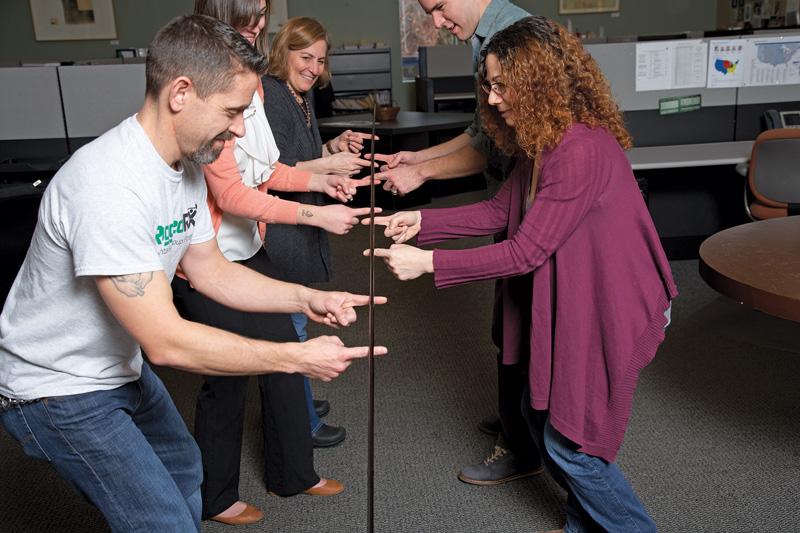Five Minute Competitive Exercises
In our LinkedIN group, Effective and Fun Training Techniques, Noreen Clifford recently posed a question about competitive games:
Here’s a challenge! I’m looking for a 5 minute competitive exercise that gets people working together, but also challenges them.
So many great ideas have come from the discussion, that I wanted to collect them and make them more available for our reference. Many thanks to all who contributed!
Competitive Games for Teams and Workplaces
Helium Stick

Helium Stick Team Building Game by Trainers Warehouse $39.95 BUY NOW
This is quick activity that promises to be fun. I usually break my groups into two teams to add the element of competition. The challenge if for teams to rest a long thin plastic rod on every participant’s index fingers and slowly lower the stick to the ground. If anyone loses contact with the rod, the group must begin again.
Although these can be hard to travel with, Helium Sticks that fold down like a tent pole are available from Trainers Warehouse.
Alternative: As an alternative to helium stick you can use hula hoops. The dynamic is different because they face each other. I try to have 6 or 7 per hoop and of course, you can get the hoops anywhere. Posted online by Larry Riggs Alternatively, you can look for 2-6′ plastic rods used to hold balloons at a party supply store] Posted online by Tammy Rahamut
Missing Piece
Get a fairly simple picture and photocopy it onto a fairly heavy card. On the back draw random lines to make a homemade jigsaw of 7 to 9 pieces. They should each be different having unique pieces. Cut up the pieces, then take the middle piece from each jigsaw and swap them so that none of the pictures will quite work out. Put each jigsaw in a zip lock bag. Either in teams or as individuals it is a race to see who completes theirs first. Eventually, they realize that they have to ask others to find their missing piece. Posted online by Dorothy Persic
Human Knot
Have two groups of 8-10 people stand in a circle shoulder to shoulder. They all reach their right hand into the circle and grab someone else’s hand (WHO’S NOT STANDING NEXT TO THEM)… Then do the same with the left hand-the left hand must grab someone different than the right hand. Then the exercise is to get untangled without letting go of one another’s hands. If you pit two teams against each other and see who can do it fastest, it quickly builds in some competition. You can have the groups do it twice. The first time around, have them do the exercise without speaking. Then let them do it using words. It’s a great example of communication, team building, and leaders emerge as well. You can also see who is more strategic in their thinking and who is more tactical. Posted online by Beth Standlee
Photo Finish
I found this one in Feeding the Zircon Gorilla . All you need is a rope for the Finish Lin and maybe a Polaroid or Digital Camera (optional). The objective is for everyone on the team to cross the finish line at exactly the same time. Instructions: Everyone must start behind the starting line and go toward the finish line and cross the finish line at exactly the same time. If someone finishes before or after anyone else, the whole team tries again from behind the starting line. The team has an unlimited number of tries.
Teams like it because it shows how we can think the task is so simple and we can get it done without much fuss; yet, that tricky human stuff gets in the way. I’ve always had a rich debrief at the end of this exercise. Posted online by Bill Woodruff
Get them to Draw it — Discover assumptions
Give one person a piece of paper that has a circle, a square, and a triangle drawn on it touching each other. Be sure to hold the paper so that the group cannot see what is on it. Tell that person their task: to get the group to draw what’s on the paper without using words to describe a shape (such as circle, square, box, triangle, pyramid etc.) After a few minutes of them being unsuccessful, take the drawing and turn to the group, show them the paper, and say “Draw this.” This demonstrates that we all bring assumptions based on past experiences to current tasks, which can impede our success. (I never said the group couldn’t be shown the paper) Posted online by Bruce Cooper
Another variation: Draw random shapes on a page (squares, triangles, oblongs – doesn’t matter). Have some of the shapes touch each other, intersect, run parallel, different sizes etc. – you can let your imagination run wild. Don’t make it too simple and put a couple of unusual shapes in there too.
Pair everyone off and have them sit back to back. Give one of the pair the page with the shapes and the other a blank piece of paper and a pen. The mission is for the person with the blank piece of paper to replicate the shape drawing as accurately as possible.
The pairs can’t look at each other during the exercise – all they have are their voices and they can speak freely to each other during the exercise – ask each other questions etc. Give them 5-10 minutes only.
Very few pairs manage to get the picture exactly right and some very funny results emerge! This exercise generates some great discussion around the importance of listening skills, questioning skills, paraphrasing, interpretation, giving accurate instructions, having a clear voice, etc. It’s particularly effective for staff who customarily talk to customers over the phone. Posted online by Sharon Ritchie
Object memory
Create a list of at least 30 words. They can be words related to your topic, or just random words of things (iPod, pencil, cell phone, candy, rock, etc.). Project the list on the screen, give everyone 1 minute to remember as many words as they can. After 1 minute, hide the list on the screen and ask people to write down as many words as they remember. See who can remember the most. Next ask people to share their list with one or two other people to come up with a master list. They will quickly see they remember more words when they collaborate. Debrief and discuss assumptions about working individually vs. collaborating. Posted online by Barbi Honeycutt, Ph.D.
Arm Wrestle
In this quick and easy activity, pairs are set up in what looks like an arm wrestle challenge. It’s up to each team of players whether they approach it as a “wrestle” or as an opportunity to create more value for both. The debrief uncovers our tendency to make assumptions and approach negotiations as a win-lose game. More here…
Group Juggling
Maybe you could shorten this one to five minutes. Start with one ball, in groups of 7 or more (I’ve done it with 19), ideally an odd number. Groups of five will make it much easier and quicker, for reasons you’ll see below. The challenge is to figure out a way to keep as many balls in the air as possible. As soon as they add a second ball, they’ll see the need to communicate and problem-solve. At some point, two balls will come to the same person. Setting the rule that you can’t throw to the person next to you, how many balls can the group juggle? Throwing and catching one ball with two hands, the group should be able to keep the same number in the air as the number of the people in the group (plus one, if they don’t through simultaneously).
Here’s the most common “solution” to maximizing the number of balls in the air:
1) They figure out that they have to throw to the same person every time, then
2) They figure out they need to keep their eyes on the person throwing to you, then
3) They may figure out that the optimum path of the ball is a star pattern, although I’ve seen overlapping loops (especially a group with even numbers of jugglers).
Pit groups against each other. Typically the group that listens and integrates ideas well beats a group with a dominant “leader”, just as in the knot exercise. Posted online by James Foley
You’re listening . . . are you paying attention?
After people have been working together for a while I ask them to stand back to back and describe what the other is wearing. It creates a lot of energy and laughing because they realise that although they have been in a workshop for an hour or longer, they haven’t really paid attention to or observed others properly. It takes only a couple of minutes but feedback is good. Posted online by Heather McLaughlin
Alphabet Exercise
Allocate a number of letters of the alphabet to each group. Give them 5 minutes to point to as many objects in the room as possible, which begin with one of their allocated letters. With no real rules, you’ll find that people get very creative. They’ll bring items in from outside the room, point to body parts, empty handbags, etc. Creates great energy and fun. Posted online by Noreen Clifford
Create an advertisement
Divide the participants into groups of four or five. Each group is given some unusual product for which they must create an advertisement. Time for preparation is about five minutes. Then they come together to design a script and decide their roles. It creates a lot of fun. I often amaze at their creativity. Posted online by Suresh Kumar
Assemble the quote
Preparation: For a group of 30 people, print 5 or 6 quotes or phrases on a paper (i.e. Face that launched a thousand ships; Fools rush in where angels fear to tread; Picture is worth a thousand words; Power corrupts; absolute power corrupts absolutely; etc.) and cut that printed paper so that each word of each phrase is a separate piece of paper. Fold up each of these 30 or so bits of paper and give one to each participant.
Activity: When you say “go,” have everyone simultaneously open their folded paper, then move around the room and find other words related to a possible phrase, from people in the room and try to complete the phrases. When they have feel they created a phrase, they can check in with the facilitator. This involves people to suddenly get energized, both in mind and body. Posted online by Vikas Chandwani
Teach a dance step
For any “working together” exercise I split into teams (minimum of 3 participants in each team) and get them to teach each other a dance step (each team has a different step). Really easy stuff, gets them working and to a deadline. They have to rotate the teacher to the other teams so in the end they all know all of the steps. People love it. If you have anyone with a disability they can still do it with verbal instruction or make them all teach it with verbal instruction only, it’s even funnier! Posted online by Jane Bowen

Pipelines Teambuilding Game by Trainers Warehouse $39.95 BUY NOW
Human Pipeline
I just facilitated “Pipeline Challenge” for a team of 14. Split the group into two teams of 7. Give a golf ball, plus 4 or 5 “pipe” sections (if you don’t want to purchase half pipes, you can use folded cardboard and some mailing tubes) to each team. Each team had to get the ball through the pipe from point A to B, which should be a distance larger than the sum of the pipe sections. To accomplish this, each person must hold a piece of the pipe at least once and they can’t stop the ball once it begins moving. (To complete the task, team members have to figure out how to pass pipe pieces down the line so the ball can keep moving).
Then I had them join up as one group, took out a few pipe pieces, and had them try it as a unified team. The activity brings up a lot of good points on how to communicate (effectively or poorly, depending on how they did), and how to identify and handle stress. They find all kinds of analogies with work (i.e. “keep the ball moving,” “know what’s coming down the pipe,” etc. View versions of it on YouTube. Posted online by Sapna Padte
Knot or No Knot
I use a 20′ blue and white rope but you can use a single color and a different length. When the group is not looking or before they arrive I put the rope in a lump on the floor. The object is to get the group to make a unanimous decision. When they pull the ends there will be a knot or not? In almost every case there will be those who feel strongly one way or another. One very important part is to have the group decide on a consequence if they get it wrong. Make it something silly but something they really don’t want to do. If any feel strongly but decide to go along with the group that’s when I start with the questions. “What if I gave you the final say? Would you still go along with the group? What if the consequence was severe? What would it take to get you to stand your ground?” With rope games, the supplies are inexpensive and the possibilities are endless. With the right questions, you can produce some great processing opportunities. Posted online by Larry Riggs
Seeing the Point
In the Seeing the Point puzzle each individual or small team has 7 pieces and is simply asked to create a number of identical shapes using the components supplied. The first few are relatively easy, but getting that last shape requires creativity and collaboration, as it can only be made once players look at the “negative space” between two shapes. The exercise brings to life a common issue facing many teams –being asked to do more with less, and then hearing “it can’t be done!” from your team members. It’s also an interesting and engaging way of introducing the concepts of ‘alignment’ and ‘synergy’: the solution to the puzzle is a visual representation of ‘doing more with less’. Posted online by Susan Landay


Thanks Susan! I always enjoy following this blog. I appreciate you taking the time to analyze the LinkedIn discussions and share them with us.
Yesterday I was looking for training games and while skimming through the posts I hit upon the Human Chain – It was an amazing experience to first try with 3 groups of 11 each and then the entire 33 trainees- Thank You For Sharing such Wonderful Insights
Very good ice break games and useful resourses
very interesting ice breakers and simple competitions
I am a Chartered Accountant and a certified corporate trainer. The games and activities mentioned are very creative, simple and thought provoking
Thanks for this, found it apt and interesting
Will definitely use this for my next morning meeting
Thanks for extremely useful information.